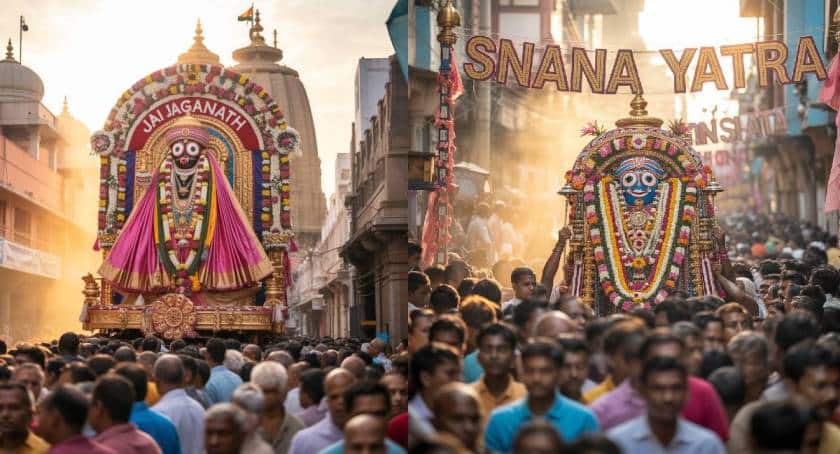Jagannath Puri’s Snana Yatra: The Divine Bathing Festival of the Gods
Some festivals dazzle with lights, some echo with music, and others fill the air with the aroma of delicious feasts. But have you ever heard of a festival where the gods take a grand bath before the world? Welcome to Snana Yatra, one of Lord Jagannath’s most sacred and mesmerizing rituals, which devotees celebrate in Puri, Odisha. This celestial bathing ceremony is more than just a tradition; it’s a spectacle of devotion, mythology, and sheer divine grace!
The Sacred Prelude, When the Gods Step Out
Every year, on the full moon day of Jyeshtha (the Hindu month that usually falls in May or June), the deities of the Jagannath Temple, Lord Jagannath, his elder brother Balabhadra, and their beloved sister Devi Subhadra are brought out of their sanctum in a grand procession. This marks one of the rare occasions when the deities leave the inner sanctum and make a public appearance before their devotees.
The temple priests carry the idols on elaborately decorated Palkis (palanquins) to the Snana Mandap, an open bathing platform within the temple complex. The excitement is electrifying. Devotees chant hymns, conch shells blow, and the rhythmic beats of traditional drums create an almost hypnotic aura.
This moment is magical as thousands gather to witness their beloved deities come alive under the open sky.
The Grand Bath, A Celestial Ritual in 108 Pots
The highlight of Snana Yatra is the ritualistic bathing of the deities with 108 pitchers of sacred water. The temple draws this water from its golden well, Suna Kua, and infuses it with divine herbs, fragrant flowers, and sandalwood paste.
Priests, adorned in traditional attire, carry the earthen pots one by one, pouring the holy water over the deities, signifying purification and renewal. As the water cascades down, devotees rejoice, believing that this sacred bath washes away sins and blesses them with prosperity and well-being.
The sight of Lord Jagannath and his siblings drenched in this sacred shower is awe-inspiring. The idols’ usually vibrant colors soften under the water, making them appear even more divine.
Hathi Besha, The Adorable Elephant Attire
Once the divine bath is complete, an extraordinary transformation takes place. The deities wear a unique elephant attire, Hathi Besha or Gajanana Besh. Lord Jagannath and Balabhadra don elephant masks, resembling Lord Ganesha, while Devi Subhadra adorns herself in delicate silk robes.
This beautiful tradition stems from a legend that states Lord Jagannath once wished to honor Lord Ganesha, and thus, he assumed this form for a day. The moment is delightful; devotees chant with renewed fervor, and the temple glows with an ethereal charm.
The Mysterious Fever of the Gods
But here’s where the divine drama takes an unexpected turn! After their grand bath, the deities fall sick. Yes, you read that right: People believe that Lord Jagannath and his siblings suffer from a divine fever.
After the Snana Yatra, temple priests move the idols to a secluded chamber called the Anasara Ghar. There, they remain away from public view for 15 days. During this time, people nurse them back to health with herbal medicines, soft foods, and soothing prayers.
Devotees believe that during these days, the Lord rejuvenates and prepares for the grandest chariot festival of all, the Rath Yatra.
The Devotees’ Longing, When the Lord is Out of Sight
For Lord Jagannath’s devotees, these 15 days are a period of longing. The temple remains closed, and no one sees their beloved deity. However, the absence only deepens their devotion.
During this period, people flock to Alarnath Temple, about 25 km from Puri. There, they believe Lord Jagannath manifests himself in a different form. The devotees go and visit the temple to seek blessings and await the Lord’s return with bated breath.
The Connection to Rath Yatra: The Journey Continues
The deities reappear once the divine fever subsides in their resplendent, fresh, and rejuvenated forms. This marks the beginning of another legendary festival: Rath Yatra, the famous chariot procession of Lord Jagannath.
People believe that Snana Yatra spiritually cleanses the Lord, preparing him for his journey to his aunt’s house (Gundicha Temple) during Rath Yatra. This sequence of events forms an unbreakable divine cycle where devotion, celebration, and faith unite extraordinarily.
Why Snana Yatra is a Festival?
Snana Yatra is a ritual that embodies faith, devotion, and the divine connection between Lord Jagannath and his devotees. It portrays the gods as living beings who bathe, fall ill, and heal, just like us. The scent of sandalwood, the echoes of sacred chants, and the mesmerizing Hathi Besha make it unforgettable. Puri’s Snana Yatra is a celestial spectacle you cannot miss if you seek devotion in its purest form. Will you answer Lord Jagannath’s call?


